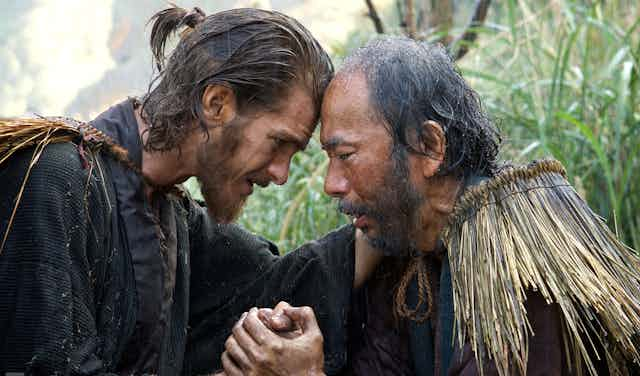Today, Martin Scorsese’s Silence will have its premiere at the Vatican, where it will be screened to hundreds of Roman Catholic priests. The famed director’s first foray into East Asia links to familiar themes of Catholic guilt and redemption, as he portrays the brutal 17th century persecution of Jesuit missionaries and their converts in Japan.
Scorsese’s film, which will open here in January, is an adaptation of Japanese author Shusaku Endo’s 1966 novel Silence. It tells the story of two Portuguese Jesuit priests (Adam Driver and Andrew Garfield) who travel to Japan at a time when Christianity was banned to find their mentor (Liam Neeson) and support the local converts. The pair are imprisoned and tortured.

The characters of the priests Cristóvão Ferreira and Sebastian Rodrigues were based on Portuguese and Italian Jesuits found in the historical record. Endo’s novel (沈黙)describes the hostile environment that leads to the missionary priests’ relinquishment of faith. They were forced to place their feet on fumi-e (踏み絵) – religious images – to demonstrate that they had given up all faith. Rodrigues (played by Garfield in the film), believes he hears Jesus’ voice telling him to apostatise by stepping on the fumi-e.
The remaining Christians went underground. The persecution continued until the ban against Christians was removed in 1873. But the indigenous Japanese who returned to Catholicism in the 1870s after 250 years of “hidden Christianity” remembered their long period of “betrayal”.

Most descendants of the native Christians lived in Nagasaki during World War II. On the 9th August, 1945, when the United States dropped the A-bomb on Urakami, a northern suburb of Nagasaki, 8500 of the 12000-strong Catholic Christian community were amongst the dead. The bomb was meant to target Nagasaki city, but because the Americans were low on fuel and clouds opened above the northern suburbs, the eventual Ground Zero happened in Urakami. Its cathedral – the biggest Catholic church in Asia at the time – was only 500 metres from Ground Zero.
Nagasaki Catholics remember the A-bomb in particular ways, as I show in my research on memory in Nagasaki. My work has involved interviewing nine Catholic survivors of the atomic bombing, as well as three other non-Catholic survivors, and members of the Urakami community.
The Catholic interviewees explained that their grandparents had been exiled to other regions of Japan in the 1860s and 1870s due to their return to Catholicism after 250 years of “hidden Christianity”.
One interviewee, Matsuo Sachiko, explained that her grandmother was a double survivor, having first survived the Christian exile (referred to as the 4th exile) imposed by the government in 1867-73 and then later, the 1945 atomic bombing. She says:
Yes… my grandmother was one of the Urakami Fourth Exile survivors and at that time there were still some of those survivors who were alive… these people still believed, everyone was able to stick at it and get through… Within their testimony, they didn’t talk about their pain.

Orphaned Ozaki Tōmei adopted a new name after the bombing, as a novice at a Polish monastery in Nagasaki. Normally Japanese monks would adopt the name of a Western saint, but he selected a Japanese saint, Ozaki Tōmei, who is a child martyr of 1597 from Nagasaki.
Ozaki remembered his mother telling him that the 26 martyrs of 1597 were marched directly past his childhood home in the middle of winter on the way to their execution. The child martyr Ozaki had been separated from his mother and was marched to Nagasaki from Kyoto. Along the way, he was able to write a letter to his mother, in which he reflected on the “transience of the world”.
My informant Ozaki linked his own experience to this boy of 1597, writing:
The experience of the atomic bombing was exactly like that. Everything in the world is breakable and vanishes. As far as the atom bomb went, there was nothing to be known of reality which was not destroyed. Koware-iku sonzai ni tayotte wa naranai. We cannot depend on a life so fragile. Nonetheless, after that, staring at reality, what I saw was the indestructible God’s existence. The Lord God who holds all created things, the source of love and life is the God I know. This is also the source of faith.

Despite the destruction around him and the tragic loss of his mother, Ozaki, orphaned monk and survivor of the atomic bombing, held on to the faith of his ancestors.
His resilience might be considered one fruit of the missionaries whose ambivalent lives are depicted by Scorsese in Silence. Ozaki turned 88 this year and continues to write prolifically on his blog.
Silence was originally controversial amongst Christians in Japan for the perceived faithlessness of its priest protagonists. Nevertheless, Scorsese’s film version – which has taken 27 years to make – is eagerly awaited in Nagasaki, where the descendants of the hidden Christians still continue to be a practising community of faith.

The 26 Martyrs’ Museum, just down the road from the Nagasaki Atomic Bomb Museum, frequently posts updates on the progress and making of the movie on its blog.
Meanwhile, another interviewee, Matsuzono (a pseudonym) told me:
Soon Martin Scorsese will release the movie, so the things we locals talk about will spread around the world…

